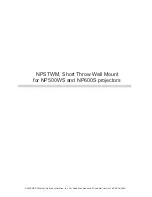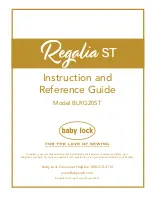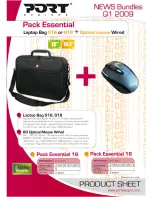
TECHNICAL NOTICE
VERTEX BEST DUO 1
A105100A (280311)
3
(EN) ENGLISH
Helmet for work at height and rescue
This document only applies to technical information for the
helmet. For technical information on the DUO LED 14 headlamp,
consult the attached Instructions for use for the DUO LED 14
headlamp.
Field of application
This helmet is designed only for work at height and rescue.
This helmet meets all requirements of the EN 397 standard,
except for the chin strap. The chinstrap has a strength of 50 daN
(requirement of the EN 12492 standard) to help keep the helmet on
the head in case of a fall.
This helmet meets optional requirements of EN 397: protection
against impacts down to -30 °C, resistance to lateral deformation
and protection against molten metal splash.
This helmet does not provide protection against electrical risks.
Do not use this helmet in activities for which it is not designed.
Activities at height present a risk of serious head injury. Wearing
a helmet can significantly reduce this risk, but cannot entirely
eliminate it.
In a major impact, the helmet deforms to absorb the maximum
amount of energy possible, sometimes to the point of destroying
the helmet.
WARNING
Activities involving the use of this equipment are inherently
dangerous.
You are responsible for your own actions and decisions.
Before using this product, you must:
- Read and understand all instructions for use.
- Get specific training in its proper use.
- Become acquainted with its capabilities and limitations.
- Understand and accept the risks involved.
Failure to heed any of these warnings may result in severe injury
or death.
Responsibility
WARNING, specific training in the activities defined in the field of
application is essential before use.
This product must only be used by competent and responsible
persons, or those placed under the direct and visual control of a
competent and responsible person.
Gaining an adequate apprenticeship in appropriate techniques and
methods of protection is your own responsibility.
You personally assume all risks and responsibilities for all damage,
injury or death which may occur during or following incorrect use of
our products in any manner whatsoever. If you are not able, or not
in a position to assume this responsibility or to take this risk, do not
use this equipment.
Nomenclature of parts
(1) Shell, (2) Headband, (3) Headband adjustment wheels, (4) Chin
strap positioning buckles, (5) Chin strap fastening and adjustment
buckle, (6) Side slots for mounting hearing protection, (7) Headlamp
clips, (8) Face shield mounting hole.
Principal materials: Acrylonitrile Butadiene Styrene (ABS) shell,
polyester straps.
Inspection, points to verify
Before each use, check the condition of the shell and the headband
attachment system (verify there are no cracks or deformation on
the outside or the inside...). Check the condition of the webbing and
stitching. Verify that the headband adjustment system and chinstrap
buckle are functioning properly.
WARNING, a major impact to the helmet can significantly reduce its
protective properties without leaving visible signs of damage. Retire
your helmet after a major impact.
Consult the details of the inspection procedure to be carried out for
each item of PPE on the Web at www.petzl.com/ppe
Contact PETZL if there is any doubt about the condition of this
product.
Instructions for use
1. Preparation
Use only the smooth areas for stickers and other markings. PETZL
stickers are approved. Do not apply paint, solvents, adhesives
or self-adhesive labels, except those recommended by PETZL
instructions.
2. Adjustments
2a. Adjust the headband to maximum size using the adjustment
wheels and place the helmet on your head.
2b. Position the adjusters under the ears. To adjust the chinstrap
backwards or forwards, slide the webbing through the chinstrap
positioning buckles.
2c. Use the adjustment wheels to increase or decrease the size of
the headband. You can adjust the height of the headband on your
forehead (two adjustment holes for the vertical position of the
headband).
2d. Fasten the chinstrap using the buckle. You must hear the buckle
“click” to ensure proper fastening. Tighten the chinstrap, it should
be snug, but comfortable. A correctly adjusted chinstrap reduces the
risk of the helmet coming off accidentally.
You must pull on the chinstrap to verify that the buckle is
properly fastened.
To open the buckle, press the button on the chinstrap fastening
buckle.
2e. Adjust the vertical position of the headband adjustment system
on your nape by sliding it up or down along the webbing.
ATTENTION, be sure there is no slack in the webbing between the
headband adjustment system and the shell of the helmet.
3. Test
Verify that the helmet is well seated and centered on the head. A
well-adjusted helmet (minimal movement front to back or side to
side), provides better protection.
Accessories
- Use the side slots to attach hearing protection. Use a screwdriver
to remove them.
- Mounting the face shield: use the face shield mounting hole, or the
side slots.
Precautions for use
- Your helmet can be damaged from improper care. Do not sit on
it, pack it too tightly, drop it, allow it to contact sharp or pointed
objects, etc.
Do not expose your helmet to high temperatures, for example by
leaving it inside a vehicle in direct sunlight.
- Certain chemical products, especially solvents, can damage your
helmet. Protect your helmet from exposure to chemicals.
- This helmet has been tested for use at temperatures between
-30 °C and +50 °C.
Petzl general information
Lifetime / When to retire your equipment
For Petzl’s plastic and textile products, the maximum lifetime is
10 years from the date of manufacture. It is indefinite for metallic
products.
ATTENTION: an exceptional event can lead you to retire a product
after only one use, depending on the type and intensity of usage
and the environment of usage (harsh environments, marine
environment, sharp edges, extreme temperatures, chemical
products, etc.).
A product must be retired when:
- It is over 10 years old and made of plastic or textiles.
- It has been subjected to a major fall (or load).
- It fails to pass inspection. You have any doubt as to its reliability.
- You do not know its full usage history.
- When it becomes obsolete due to changes in legislation,
standards, technique or incompatibility with other equipment, etc.
Destroy retired equipment to prevent further use.
Product inspection
In addition to the inspection before each use, an in-depth inspection
must be carried out by a competent inspector. The frequency of the
in-depth inspection must be governed by applicable legislation, and
the type and the intensity of use. Petzl recommends an inspection at
least once every 12 months.
To help maintain product traceability, do not remove any markings
or labels.
Inspection results should be recorded on a form with the following
details: type of equipment, model, manufacturer contact information,
serial number or individual number, date of manufacture, date
of purchase, date of first use, date of next periodic inspection,
problems, comments, the name and signature of the inspector.
See an example at www.petzl.com/ppe
Storage, transport
Decrease the size of the headband and tuck it into the helmet.
Do not pack your helmet too tightly.
Store the product in a dry place away from exposure to UV,
chemicals, extreme temperatures, etc.
Cleaning
Clean the shell with soap and lukewarm water, then rinse with water.
Modifications, repairs
Modifications and repairs outside of Petzl facilities are prohibited
(except replacement parts).
3-year guarantee
Against all material or manufacturing defect. Exclusions: normal
wear and tear, oxidation, modifications or alterations, incorrect
storage, poor maintenance, negligence, uses for which this product
is not designed.
Responsibility
PETZL is not responsible for the consequences, direct, indirect or
accidental, or any other type of damage befalling or resulting from
the use of its products.



































